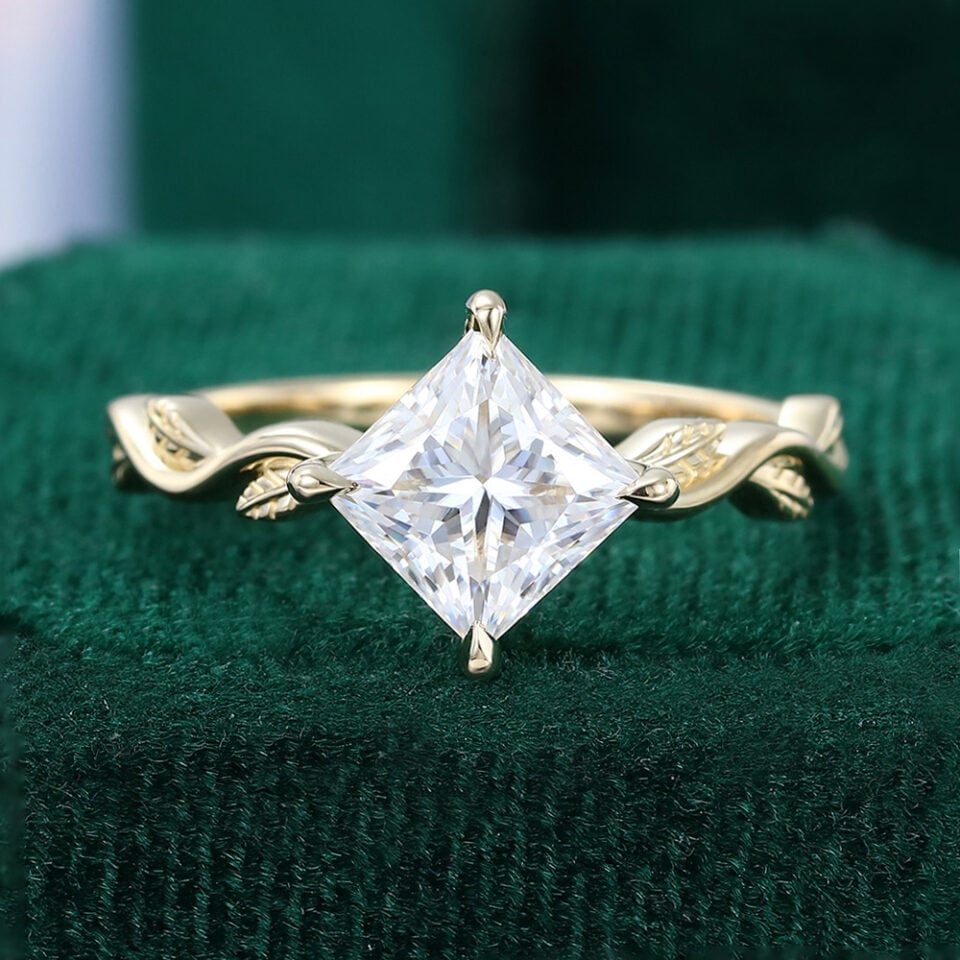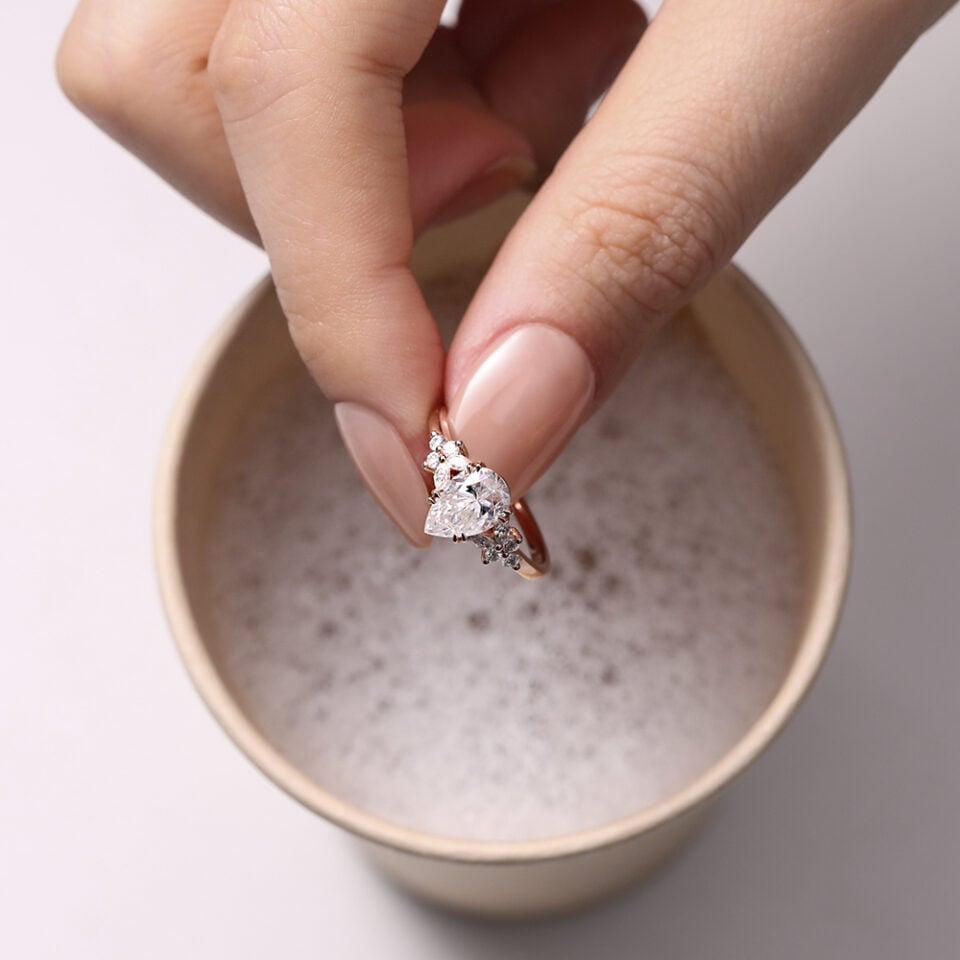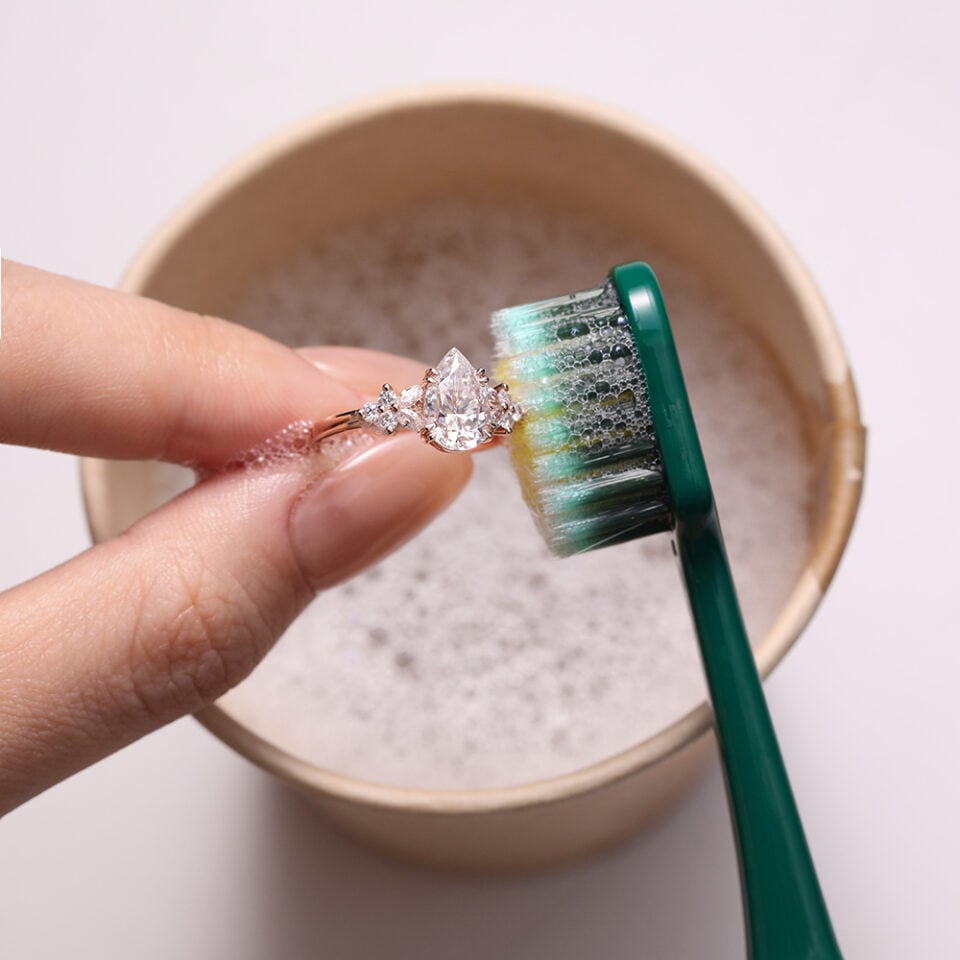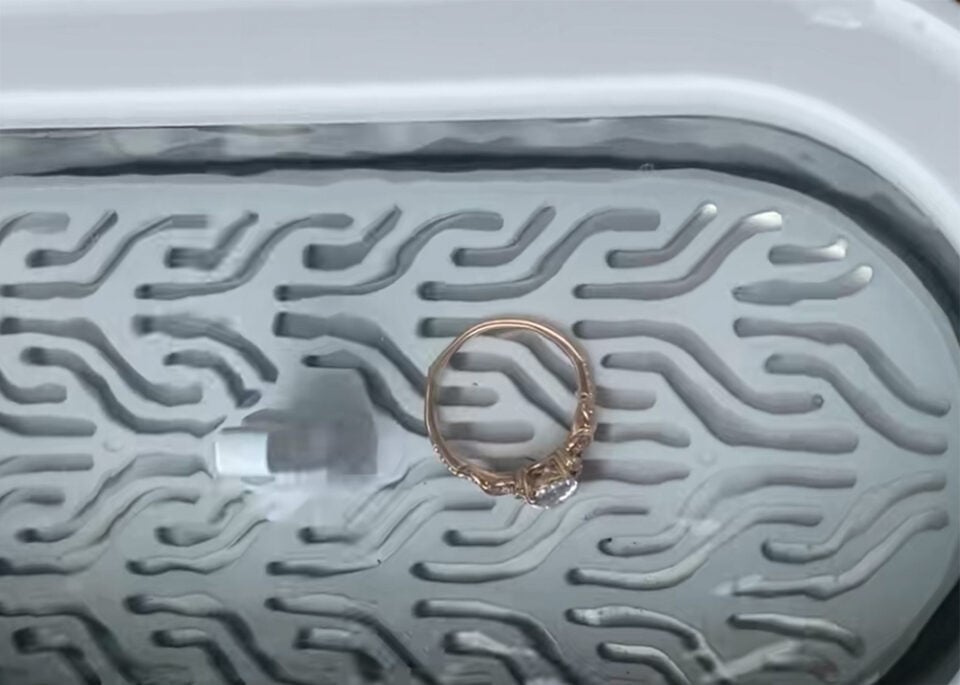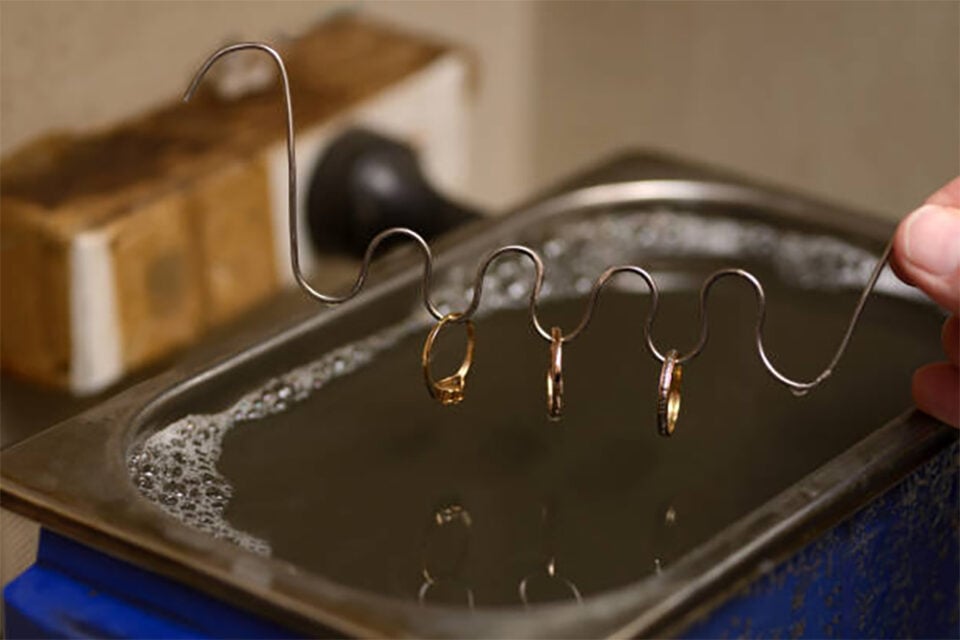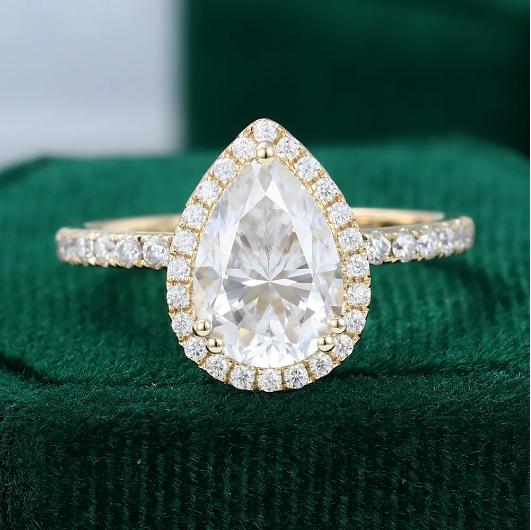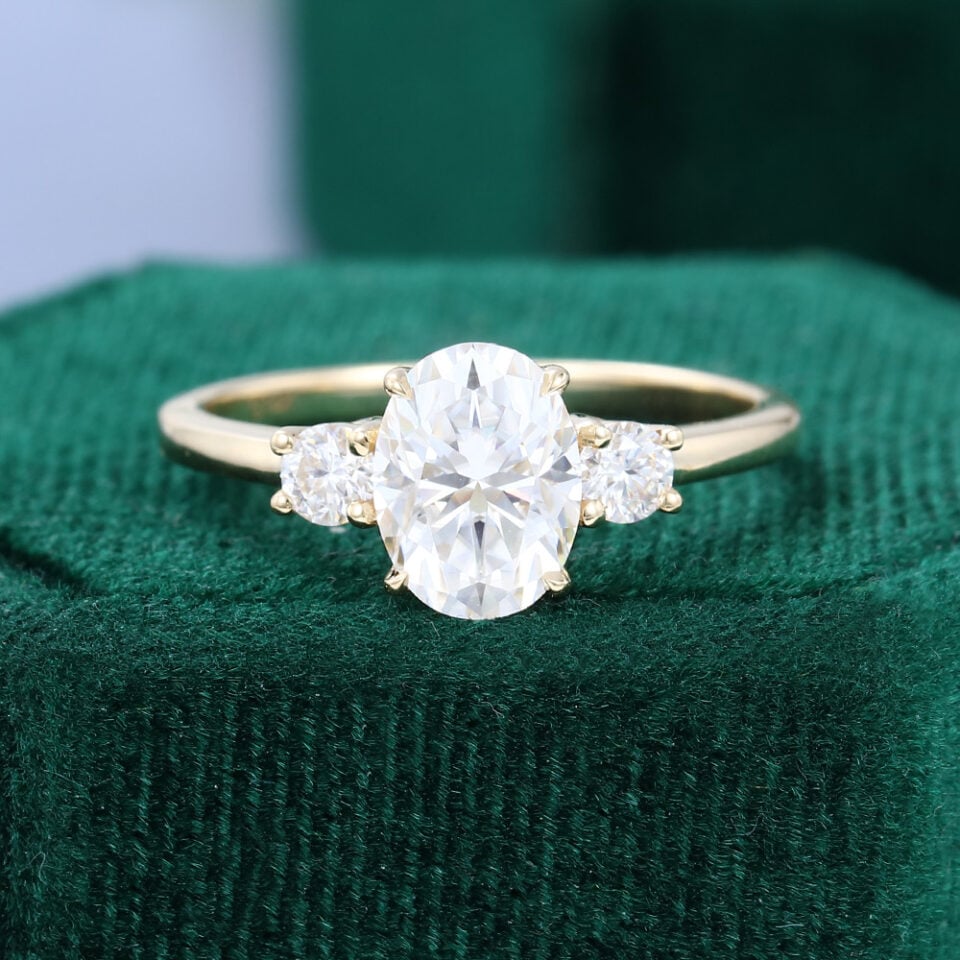- by Freya Miller
- August 13, 2025
- About Moissanite
Quick Navigation
Quick Navigation
Moissanite engagement rings have become a popular choice for modern couples, thanks to their exceptional sparkle, durability, and budget-friendly price point. Yet despite their growing popularity, many people still hold inaccurate beliefs about this stunning gemstone. These misconceptions often stem from a mix of outdated information, confusion with other imitation stones, and marketing messages designed to promote more expensive alternatives.
In this guide, we will debunk the most common myths about moissanite engagement rings. From concerns about appearance and durability to questions about value and symbolism, we will uncover the facts so you can make an informed decision based on truth—not hearsay.
Myth #1 – Moissanite Engagement Ring Looks 'Too Fake'
Myth #1 – Moissanite Engagement Ring Looks 'Too Fake'
Moissanite has higher dispersion than lab diamonds or mined diamonds, so it throws stronger rainbow flashes under direct, point-source light (think sunny sidewalks, jewelry store spots, phone flash). Some viewers equate that extra fire with a ‘too sparkly to be real’ look. The conclusion is understandable, but it is not accurate.
The facts
Moissanite is a real gemstone with a distinct crystal structure and optical profile.
Its refractive index and dispersion are naturally higher than diamond, which creates a different light performance, not a cheap imitation effect.
In diffused daylight and most indoor environments, moissanite presents as bright, clear, and diamond-like; in punchy lighting it shows more rainbow fire. Both are normal.
If you love a restrained, elegant look
You can tune the appearance with smart choices in cut, size, and setting:
Choose step cuts (emerald, asscher): broader, mirror-like flashes and less rainbow fire.
Consider antique or fewer-facet cuts (rose-cuts or modified cushions) for softer scintillation.
Right-size the center stone: very large stones naturally display more fire; slightly downsizing or using a halo to distribute sparkle can create a calmer look.
Go bezel or half-bezel: a thin metal rim tames edge-to-edge sparkle and adds a modern vibe.
Pair with a matte or brushed band to reduce overall flash and emphasize form.
Color choice: D–F delivers a crisp white look; G–H can read a touch warmer and more natural on many skin tones.
If you want maximum sparkle
- Brilliant cuts (round, oval, pear, princess, radiant) showcase moissanite’s signature fire.
- Pavé halos and bands amplify scintillation and make the center appear larger
Lighting and cleanliness matter
- Expect stronger rainbows in spotlights and midday sun; under office, home, and overcast lighting the effect is gentler.
- Keep the stone clean. Oil and lotion films mute white light return and can make color flashes look uneven. A quick warm-water wash with mild soap and a soft brush brings the balance back.
Bottom line
Different does not mean fake. Moissanite’s light show is part of its identity. With the right cut, size, and setting, you can dial the look anywhere from subtle and sophisticated to bold and brilliant—so it suits the person who will wear it every day.
Myth #2 – Moissanite Engagement Ring Scratches Easily
Myth #2 – Moissanite Engagement Ring Scratches Easily
Moissanite often gets lumped together with lower-hardness simulants like cubic zirconia. That confusion leads to the idea that it will mark up fast with daily wear.
The facts
Excellent hardness: Moissanite ranks about 9.25 on the Mohs scale, second only to diamond among common jewelry gems. That means it resists scratches far better than CZ (≈8) and even sapphire (9) is slightly softer.
Durability for daily wear: Hardness protects against surface abrasion from pockets, desks, dishes, and gym equipment. Normal activities won’t haze a moissanite the way they can softer stones.
Hardness ≠ toughness: No gemstone is indestructible. A very sharp blow can chip facets or a thin girdle on any stone. The risk is low in everyday life but worth acknowledging.
Real-world tips to keep it pristine
Mind hard knocks: Take rings off for heavy lifting, contact sports, or tools-on-metal tasks.
Protect the setting: Most damage comes from bent or worn prongs, not the stone. Choose durable metal materials like 14K gold, 18K gold, or platinum. Have prongs checked every 6–12 months (or sooner if you snag the ring).
Clean regularly: Oils build up and dull brilliance long before true scratches happen. Warm water + mild soap + soft brush works; ultrasonic is generally fine for moissanite, but avoid if the setting has fragile pavé or loose stones.
Store smart: In a fabric-lined box or separate pouch, not tossed with diamonds (which can scratch nearly anything).
Bottom line
Moissanite is highly scratch-resistant and well suited to lifetime wear in an engagement ring. Treat it like fine jewelry—not a power tool—and it will keep its crisp, bright polish for years.
Myth #3 – Moissanite Engagement Ring Turns Cloudy Over Time
Myth #3 – Moissanite Engagement Ring Turns Cloudy Over Time
Older low-quality simulants (like some glass or CZ) can abrade or discolor with wear, so people assume moissanite will do the same.
The facts
Moissanite (silicon carbide) is stable and non-porous. It does not absorb oils or water, and it does not naturally turn cloudy or yellow with age.
What most people call “cloudy” is almost always surface buildup (soap film, lotion, hard-water minerals) or grime trapped under the stone—not a change in the gem itself.
What can make it look cloudy
Residue films: hand cream, hairspray, sunscreen, kitchen oils.
Hard-water deposits: mineral spots after rinsing but not drying.
Blocked pavilion: debris under the basket/culet reduces light return.
Setting optics: warm yellow gold can reflect a gentle warmth into near-colorless stones; that is not clouding.
Dirty metalwork: dulled pavé or tarnished prongs can make the entire head read “flat,” even if the center is fine.
How to fix it (quick routine, 5–10 minutes)
Soak in warm water with a drop of mild dish soap (no moisturizers) for 10–15 minutes.
Brush gently with a soft toothbrush—especially the underside (pavilion) and around prongs.
Rinse thoroughly under warm running water.
Dry with a lint-free cloth or let air-dry to avoid spots.
Deeper clean (when buildup is stubborn)
Use some targeted solutions, such as vinegar or household ammonia.
Use an at-home ultrasonic jewelry cleaner
Visit your local jeweler for professional ultrasonic & steam cleaning
Prevention tips
Put your ring on after lotions, makeup, and hairspray; take it off for heavy creams or sunscreen.
Weekly quick clean if you wear it daily.
After rinsing, pat dry instead of air-drying in hard-water areas to prevent mineral spots.
Periodic checkups (every 6–12 months) to ensure prongs are snug and the underside stays clear.
Bottom line
Quality moissanite does not turn cloudy. Keep it clean,especially the underside,and it will stay bright, crisp, and sparkling for the long run! For more related information, please refer to our moissanite ring care guide.
Myth #4 – Moissanite Is Too Cheap for an Engagement Ring
Myth #4 – Moissanite Is Too Cheap for an Engagement Ring
Decades of diamond-first marketing taught us that a higher price tag equals a more meaningful proposal. When people see moissanite’s friendlier pricing, they assume it is less worthy for a once-in-a-lifetime moment.
The facts
Price reflects supply, not sentiment. Moissanite is grown in controlled labs, so supply is steady and margins don’t rely on rarity. Lower price ≠ lower beauty or durability.
Performance-first value. With exceptional brilliance, fire, and excellent hardness, moissanite offers premium optics without the premium markup.
Meaning is personal. An engagement ring’s emotional value comes from the relationship and the thought behind the design, not the receipt total.
What a smart budget unlocks
Better craftsmanship and setting. Allocate more to a durable, secure, well-made setting (solid gold, thicker prongs, hand-finishing) that protects the stone for decades.
Design freedom. Explore custom details, unique setting, bigger stone, matched wedding bands—without blowing the budget.
Life priorities. Keep funds for the proposal trip, wedding photography, or a first-home down payment, memories that matter just as much.
Social proof is shifting
More couples now choose lab-grown gems and moissanite for ethical concerns, transparency, and design flexibility. The modern standard is authenticity, picking what fits your values and lifestyle.
Bottom line
Affordable does not mean inappropriate. Moissanite lets you invest in thoughtful design and lasting craftsmanship while honoring what the ring represents: your promise, not a price point.
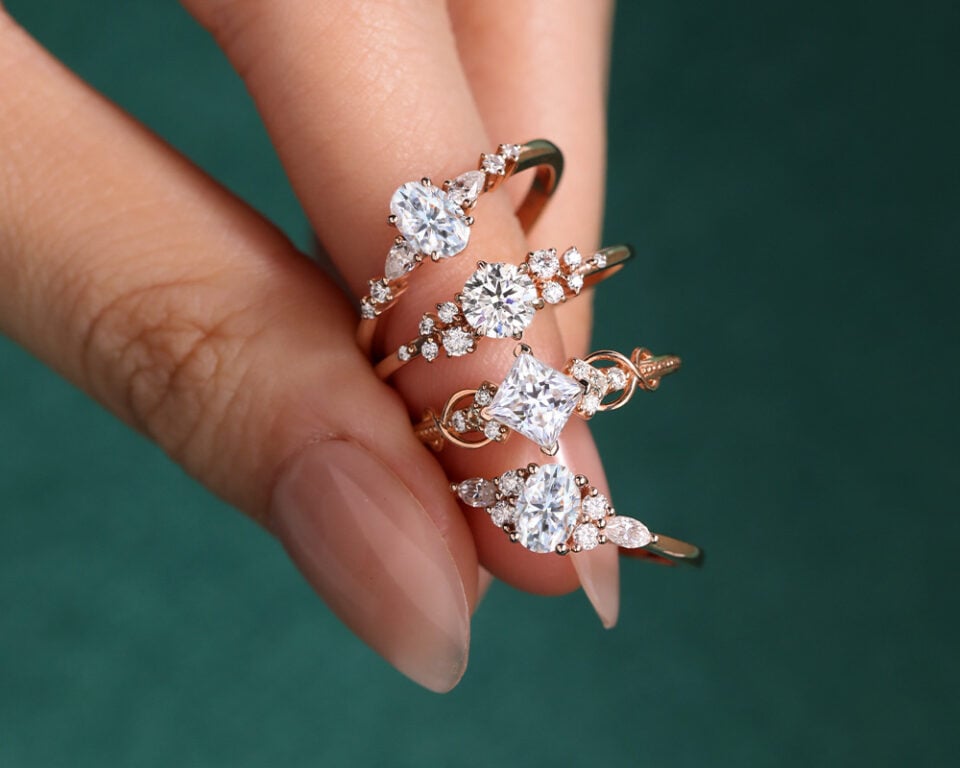
Myth #5 – Moissanite Engagement Rings Have No Resale Value
Myth #5 – Moissanite Engagement Rings Have No Resale Value
People often hear that only diamonds hold value, so they assume moissanite ring has none. In reality, most retail jewelry, diamonds included, depreciates on the secondary market.
The facts
Resale ≠ retail. Once a piece leaves the showcase, its resale price reflects supply, demand, and condition, not the original ticket price.
Moissanite engagement rings do have resale value, but like most gems, it typically resells for less than retail. The buyer pool (private buyers, consignment, jewelers) shapes the price.
Diamond engagement rings also resell below retail in most cases. The idea that only diamonds ‘appreciate’ is a marketing myth, not a market rule.
What resale typically looks like
Channels: peer-to-peer marketplaces, local jewelers, consignment, auction sites.
Pricing reality: classic shapes and sizes (round/oval 1–2 ct range), colorless grades, eye clean, and quality settings in solid gold or platinum attract more buyers and better offers.
Metal value matters: 14k/18k gold or platinum settings retain melt/scrap value that costume or plated pieces do not.
How to maximize future flexibility (if you care about resale/upgrade)
Choose classic designs (timeless solitaire, three-stone, clean halos) over ultra-niche trends.
Pick precious metals (14k/18k gold, platinum) for intrinsic value and wider demand.
Stick to popular stone shapes/sizes for broader buyer appeal.
Keep everything (receipt, photos, maintenance records, original box).
Bottom line
It is true that moissanite like almost all jewelry won’t resell at its original retail price. But that does not make it ‘worthless.’ If resale optionality matters to you, smart choices in design and metal can meaningfully improve your outcomes.
Final Thoughts – Why Moissanite Is Worth Considering
Final Thoughts – Why Moissanite Is Worth Considering
When you cut through the noise, moissanite engagement rings check the boxes that matter: beauty you can see, durability you can trust, and value that lets you invest in thoughtful design. It does not look ‘fake’ by definition, it does not scratch easily, it does not turn cloudy, it is a real gemstone species grown for jewelry, its friendlier price is about supply not sentiment, and resale behaves like most fine jewelry on the secondary market.
Quick takeaways
Tune the look you want with stone shape, size, and setting (step cuts and bezels for subtle, brilliant cuts and pavé/halo for maximum sparkle).
Expect excellent everyday durability (Mohs ~9.25) and keep performance high with simple weekly cleaning.
Put more of your budget into craftsmanship and design instead of rarity premiums.
If future flexibility matters, choose timeless styles in precious metals and keep your documentation.
Ready to explore next steps? See our guides on moissanite engagement ring setting types, or start a custom design to make the details yours. Your unique love story deserves a beautiful ring that shines for all the right reasons.



